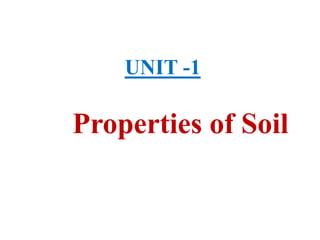
1.1 properties of soil
- 1. Properties of Soil UNIT -1
- 2. INTRODUCTION TO GEOTECHNICAL ENGINEERING: • Geotechnical Engineering is a term which includes Soil Mechanics, Rock Mechanics and Geology. • Soil Mechanics deals with action of forces on soil and with flow of water on soil. • Rock Mechanics deals with mechanics of rock. • Geology deals with the study of Earth, the rocks of which it is composed, and the processes by which they change. • Out of the above 3, we mainly deal with Soil Mechanics for this course.
- 3. APPLICATIONS TO CIVIL ENGINEERING: A) Foundations: • Every civil engineering structure – building or bridge or dam, it is founded on or below the surface of earth. • Foundations are required to transmit the load of the structure safely to the soil. • Foundation Engineering is an important branch in Geotechnical Engineering.
- 5. B) Retaining Structures: • When sufficient space is not available for a mass of soil to spread and form a safe slope, a structure is required to retain the soil. • Geotechnical Engineering gives the theories of Earth Pressure on retaining structures.
- 6. C) Slope Stability: • Whether natural slope or man nade slope – to prevent landslides, slope stability is important. • Geotechnical Engineering provides methods to check stability of slopes.
- 7. D) Pavement Design: • A pavement is a hard crust placed on soil for the purpose of providing a smooth and strong surface on which the vehicles can move. • Pavement consists of subgrade, sub base course, base course and surface course. • Behaviour of subgrade on various loading and environmental conditions are studied in Geotechnical Engineering. PAVEMENT DETAILS
- 8. COMPLEXITY OF SOIL STRUCTURE: • Soil is a highly complex material. • It differs from conventional structural materials such as steel and concrete. • Properties of steel can be accurately controlled and properties of concrete can be controlled to some extent during its preparation. • Soil is a material which has been subjected to changes of nature and we cannot control that. • Thus, soil is a heterogeneous and unpredictable material. • Properties of soil also change with change in environmental, loading and drainage conditions. • Main engineering properties of steel and concrete are Elastic Modulus (stress/strain), Tensile strength and Compressive Strength. • Most of the design work can be done if these above properties are known.
- 9. • However, engineering properties of soils depend on a lot of factors and it is not possible to characterize them by 2 or 3 parameters. • Detailed testing is required to determine the characteristics of soil and only then design can be done. • Steel and concrete can be inspected before use, soils for foundations are at great depth and not open to inspection. MAJOR SOIL DEPOSITS OF INDIA: Soil deposits of India can be classified into 5 major groups. A) Alluvial Soil: • A large part of North India is covered with Alluvial soils. • The distinct characteristics of Alluvial deposits is the existence of alternating layers of sand, silt and clay. • Thickness of each layer depends on the local terrain and nature of floods in the rivers causing deposition.
- 10. B) Black Cotton Soil: • A large portion of central India and a portion of South India are covered with Black Cotton Soils. • These soils are residual deposits formed from basalt rocks. • These soils are clays of high plasticity. • They have high shrinkage and swelling properties. • Shear strength, Bearing capacity of this soil are extremely low. C) Laterite Soil: • Laterite soils are formed by decomposition of rock, removal of bases and silica and accumulation of Iron oxide and Aluminium oxide. • Presence of Iron oxide gives these soils the characteristic red or pink colour. • These are residual soils formed from basalt. (Basalt: Most common type of solidified lava; a dense dark grey fine- grained igneous rock)
- 11. • These soils exist in Central, Southern and Eastern India. • These are soft and can be cut with a chisel when wet but they become hard as time passes. D) Desert Soil: • A large part of Rajasthan and adjoining states is covered with sand dunes. • In this area, arid conditions exist with little rainfall. (Arid: No water) • Size of the particles is in the range of fine sands. • They are uniform in gradation. • (Gradation): Proportion of material of each grain size present in a soil. E) Marine Soil: • They contain a large amount of organic matter. • They are present along the coast. • They have very low shear strength, highly plastic,highly compressible.
- 12. FIELD IDENTIFICATION OF SOILS: Cohesion: It is the bonding force or attractive fore between the particles of fine grained soils that creates shear strength. Sizes of soil: Gravel – Between 80 mm and 4.75 mm. Sand – Between 4.75 mm and 75 microns. Silt – Between 75 microns and 0.002 mm. Clay – Finer than 0.002 mm.
- 13. Thank You
